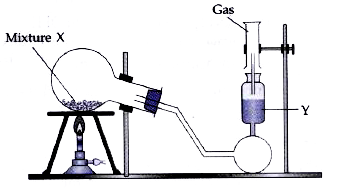State the laboratory method for the production of the methane gas.
Step-by-Step Solution for the Laboratory Method of Producing Methane Gas:
1. Identify the Reactants:
- The primary reactant for producing methane gas in the laboratory is aluminum carbide (Al4C3).
2. Hydrolysis of Aluminum Carbide:
- To produce methane, aluminum carbide is hydrolyzed. This means that aluminum carbide is reacted with water (H2O).
3. Chemical Reaction:
- The chemical reaction for the hydrolysis of aluminum carbide can be represented as follows:
Al4C3+12H2O→4Al(OH)3+3CH4
- In this reaction, aluminum hydroxide (Al(OH)3) is produced as a solid, and methane (CH4) is released as a gas.
4. Balancing the Reaction:
- Ensure that the reaction is balanced:
- Aluminum (Al): 4 on both sides
- Carbon (C): 3 on both sides
- Hydrogen (H): 12 on both sides (from water and methane)
- The reaction is now balanced.
5. Collecting the Methane Gas:
- Since methane is not soluble in water, it can be collected by allowing it to accumulate over the surface of water in a gas collection apparatus. The methane gas will rise and can be captured.
6. Purity of Methane:
- The methane produced through this method is relatively pure because the aluminum hydroxide formed is in an aqueous phase and does not interfere with the methane gas.
- The primary reactant for producing methane gas in the laboratory is aluminum carbide (Al4C3).
- To produce methane, aluminum carbide is hydrolyzed. This means that aluminum carbide is reacted with water (H2O).
- The chemical reaction for the hydrolysis of aluminum carbide can be represented as follows:
Al4C3+12H2O→4Al(OH)3+3CH4
- In this reaction, aluminum hydroxide (Al(OH)3) is produced as a solid, and methane (CH4) is released as a gas.
- Ensure that the reaction is balanced:
- Aluminum (Al): 4 on both sides
- Carbon (C): 3 on both sides
- Hydrogen (H): 12 on both sides (from water and methane)
- The reaction is now balanced.
- Since methane is not soluble in water, it can be collected by allowing it to accumulate over the surface of water in a gas collection apparatus. The methane gas will rise and can be captured.
- The methane produced through this method is relatively pure because the aluminum hydroxide formed is in an aqueous phase and does not interfere with the methane gas.
Similar Questions
For production of methane , methanogens
View Solution(i)Name the industrial method for the production of hydrogen gas.
(ii)Name the catalyst used in the above process.
View SolutionLoewig method is used for the preparation of
View SolutionBacteria involved in production of methane gas are
View SolutionDescribe Kolbe's electrolytic method for the preparation of methane.
View SolutionLaboratory method for the preperation of diborane involves the oxidation of
View SolutionWrite the balanced chemical equation for the laboratory preparation of hydrogen chloride gas.
View SolutionWhen 20 ml of methane and 20 ml of oxygen are exploded together and the reaction mixture is cooled to laboratory temperature. The resulting volume of the mixture is
View SolutionState one relevant reason for
Soda lime is preferred to sodium hydroxide in the laboratory preparation of methane.
View SolutionThe diagram shows an experimental set up for the laboratory preparation of a pungent smelling gas. The gas is alkaline in nature.
How will you find that the jar is full of gas?

View Solution
